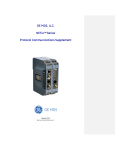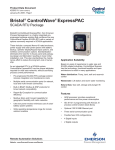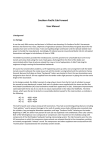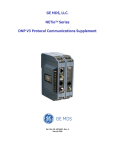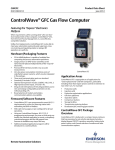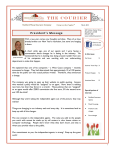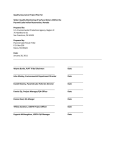Download Microwave Data Systems MDS entraNET 2400 Installation guide
Transcript
System Part Number: 900-0782-81, -91 Document P/N: 551-0782-81, Rev C1 December 2014 Installation Guide RMAS-120-81 and -91 UHF Radio Extensions Introduction 900 MHz version: The RMAS-120-81 and -91 adds a UHF Radio Link to the RMAS-120 Remote Monitor and Alarm System. The UHF Radio Link provides an alternative transmission channel for the RF Repeater Alarm data that is otherwise carried by added modulation to the repeated microwave carriers. System Part Number: RMAS-120-01 PN: UHF Telemetry Tx PN: UHF Telemetry Rx PN: The -81 UHF Radio operates in the 902 ~ 928 MHz band while the -91 UHF Radio operates in the 2400 MHz band. Both use frequency hopping spread spectrum coding. These are license free bands under US-FCC Part 15.247 rules and Canadian ISC document RSS-210. The duplex radios are GE MDS NETioB-900 and NETioB-2400 with Expansion Modules. The RMAS-120-01 Alarm Transmitter unit’s local alarm points are routed to the MDS radio link equipment. Eight (8) alarm points are transported in this RMAS-120-81 configuration. Other configurations can transport 14 or 20 alarm points. Contact PESi for availability. 900-0782-81 090-0781-01 090-0783-81 090-0784-81 2400 MHz version System Part Number: RMAS-120-01 PN: UHF Telemetry Tx PN: UHF Telemetry Rx PN: 900-0782-91 090-0781-01 090-0783-91 090-0784-91 UHF Telemetry and RMAS Transmitter Assembly The 090-0783-81, -91 UHF Telemetry Transmitter Assembly and 090-0781-01 RMAS-120 Alarm Transmitter Assembly are shown in Figure 1. Additionally, the battery temperature voltage is transported on an analog voltage to instrumentation current loop channel. Alarms are sent from the RF Repeater site to the RMAS-120-81, -91 UHF Telemetry Receiver located at the associated microwave radio terminal end. The duplex radio link is configured with one control channel from the Telemetry Receiver to the RF Repeater site. This control channel provides a closure at the repeater site and can be used as required. Examples are: GenSet start and equipment shutdown. Figure 1, RMAS UHF Transmitter Assy The radio link equipment is normally configured at the PESi factory for the particular field application. See the factory test data sheet for more details. Peninsula Engineering Solutions may change specifications as necessary to meet industry requirements. Peninsula Engineering Solutions, inc. POB 1095 Danville, California 94526, USA © 2014 Peninsula Engineering Solutions, inc. Telephone +1 925 837-2243 Facsimile +1 925 837-2298 Internet www.peninsulaengineering.com System Part Number: 900-0782-81, -91 Document P/N: 551-0782-81, Rev C1 December 2014 Installation Guide Mounting Transmit Power The UHF Transmitter Assembly mounts inside the repeater door or in a 19-inch rack below the RF Repeater. The unit is 8U high. Recommend using the 100mW, +20 dBm lower power setting for LOS paths. The lower power setting also reduces the DC current load and is best for solar powered sites. Peninsula’s UHF antenna kits use 12 dBi gain antennas and 3/8-inch or ½-inch coax. At typical 50-Ft feedline plus the jumper at the alarm equipment has 2 dB of loss. In this case, the maximum output power setting is +26 dBm. UHF Transmitter Settings The GE MDS NETio radio has been factory set for the application. If changes are required, see the section Admin Access to the GE MDS NETio following or the GE MDS NETio manual for details, 05-4457A01, Rev D or later, PES PN 551-0790-01. Figure 2, RMAS UHF Tx in RF Repeater Antenna A 902 ~ 928 MHz or 2400 MHz directional antenna should be installed on the tower or antenna support structure that also mounts the microwave antennas. Normally, the UHF path is parallel to one of the microwave paths and Line-of-Sight is expected. Antenna feedline can be 3/8” or ½” Foam Filled Coax terminated in a Type-N(f) connector at the radio end. The gain of the antenna and feedline combination may be limited by regulations. The 900 MHz maximum EIRP is +36 dBm by US-FCC regulations. With the transmitter set at low power, 100mW or +20 dBm, the antenna gain – feeder loss must not exceed 16 dBi. If the highest power setting is used, 1-Watt or +30 dBm, the net gain limit is 6dBi. The radios transmit power may be set in 1 dB increments from +20 to +30 dBm for 900 MHz and +20 to +27 dBm for 2400 MHz. Figure 3, UHF Tx Antenna Cable Lightning Arrestors are recommended. Peninsula Engineering Solutions may change specifications as necessary to meet industry requirements. Peninsula Engineering Solutions, inc. POB 1095 Danville, California 94526, USA © 2014 Peninsula Engineering Solutions, inc. Telephone +1 925 837-2243 Facsimile +1 925 837-2298 Internet www.peninsulaengineering.com System Part Number: 900-0782-81, -91 Document P/N: 551-0782-81, Rev C1 December 2014 Installation Guide Antenna Kit Connections If an antenna kit from PESi was supplied, install the included lightning arrestor at the bottom of the RF Repeater enclosure. Punch or drill a 5/8-inch diameter hole for the Type N(f) connector and mounting bracket. Locate the hole toward the left side as viewed from the front. Be sure the internal antenna cable jumper will reach the hole location. Follow the installation directions supplied with the lightning arrestor. Figure 4, UHF Tx Lightning Arrestor, at bottom of RF Repeater enclosure UHF & RMAS Tx Assy Connect to: UHF Antenna Jumper, Type-N(m), Fig. 3 UHF Antenna feedline, Type-N(f) (Lightning Arrestor) Door on Screw Terminal Block Wht/Blu/Blk Wht/Blk/Slt Repeater Door Switch cable, (no polarity). Wht/Grn/Blk Wht/Yel/Blk RF Power Monitor F1 F1 BNC coax cable RF Power Monitor F2 F2 BNC coax cable J1 Adapter Cable, 20 Pin Repeater Alarm Cable, P1 Waveguide Pressure Sensor RMAS TX Internal TB-1 IN - 5 IN - 4 Waveguide Pressure Sensor Cable (no polarity) Green Blue Temperature Sensor RMAS TX Internal TB-1 C–3 B–2 A–1 Temperature Sensor Cable Yellow - C White - B Black - A Caution! Once battery is connected, the UHF Transmitter will begin transmitting. Battery A+ 12 VDC or 8.5 VDC Battery B+ 12 VDC or 8.5 VDC DC Power Cable with 3-pin plug P1 is attached to the RMAS Tx TB-1 and connects to the RF Repeater Aux DC connector located on the repeater door. 12V repeaters = P6 24V repeaters = P7 Figure 5, Screw Terminal Block TB-1, UHF Tx with P1 DC Power Cable Note the PWR and LINK LEDs on the MDS Transmitter. Both should be ON. Peninsula Engineering Solutions may change specifications as necessary to meet industry requirements. Peninsula Engineering Solutions, inc. POB 1095 Danville, California 94526, USA © 2014 Peninsula Engineering Solutions, inc. Telephone +1 925 837-2243 Facsimile +1 925 837-2298 Internet www.peninsulaengineering.com System Part Number: 900-0782-81, -91 Document P/N: 551-0782-81, Rev C1 December 2014 Installation Guide Turn on the RMAS-120 Alarm Transmitter and verify operation by pressing the LED Switch. All alarm LEDs should light briefly (lamp test) and then only the actual alarms will remain ON. Confirm the RMAS-120 Alarm Transmitter OPTO COPLR jumper is set to ENB. UHF Receiver Settings The GE MDS NETio radio has been factory set for the application. If changes are required, see the section Admin Access to the GE MDS NETio following, or the GE MDS NETio manual for details, 05-4457A01, Rev D or later, PES PN 551-0790-01. RMAS-120-81 UHF Telemetry Receiver The 090-0784-81, -91 UHF Assembly is shown in Figure 6. Receiver Figure 6, UHF Telemetry Receiver Assy Mounting The UHF Receiver Assembly mounts in a 19-inch rack. The unit is 2U high with a 5-inch front projection. Antenna A directional antenna should be installed on the tower or antenna support structure that also mounts the microwave antennas. Normally, the UHF path is parallel to one of the microwave paths and Line-of-Sight is expected. Antenna feedline can be 3/8” or ½” Foam Filled Coax terminated in a Type-N(m) connector at the radio end. Figure 7, Rx MDS Modules Connections UHF Receiver Assy Connect to: UHF Antenna Port, Type-N(f) UHF Antenna feedline, Type-N(m) Caution! Once battery is connected, the UHF Receiver will begin operating. This unit includes a UHF transmitter. 20-60 VDC IN, GND, +, Isolated Input Fuse at 1 Amp For Negative Battery, jumper the (+) terminal to GND and connect to Rack Ground. Connect fused (-) Battery to the (-) terminal. The gain of the antenna and feedline combination may be limited by regulations. The maximum EIRP is +36 dBm. With the transmitter set at low power, 100mW or +20 dBm, the antenna gain – feeder loss must not exceed 16 dBi. If the high power setting is used, 1-Watt or +30 dBm, the net gain limit is 6 dBi. Lightning Arrestor is recommended. Figure 8, UHF Receiver, Rear Peninsula Engineering Solutions may change specifications as necessary to meet industry requirements. Peninsula Engineering Solutions, inc. POB 1095 Danville, California 94526, USA © 2014 Peninsula Engineering Solutions, inc. Telephone +1 925 837-2243 Facsimile +1 925 837-2298 Internet www.peninsulaengineering.com System Part Number: 900-0782-81, -91 Document P/N: 551-0782-81, Rev C1 December 2014 Installation Guide Performance can be verified at the RMAS UHF Telemetry Transmitter by connecting a computer terminal to COM 1 serial data port on the MDS base module. This port is an RJ-45 and requires an adapter to 9-pin subminiature female. The adapter is supplied with the RMAS unit. Figure 9, Terminal Block, UHF Rx Figure 11, COM Adapter Cable The COM Port provides access to the MDS Base (radio) module and to the attached expansion module. The MDS modules are interconnected by a module to module bus. MDS Settings Figure 10, UHF Rx, J1 Alarm Points, UHF Antenna Port Peninsula’s factory configures the MDS modules to communicate properly and assigns the alarm points. All the factory settings are recorded in the Test Data Sheet supplied with the order. To change any of the factory settings, please see the next section Admin Access. Note the indicator LED on the UHF Receiver Front Panel. The Green POWER ON LED will be ON when battery is applied. Verification Once the RMAS UHF transmitter and receiver are installed, connected and powered, the RMAS UHF Telemetry Receiver should acquire the radio signal and synchronize. Connect a computer terminal to the COM 1 port on the receiver’s front panel to verify receive signal level and performance. Minimum 900 MHz receive signal level, RSSI is -106 dBm. Minimum 2400 MHz receive signal level, RSSI is 104 dBm Recommend RSSI -95 dBm to -60 dBm for best service. Reasons that changes may be required: 1. Multiple RMAS or MDS links operating nearby require network address or unit ID to change. 2. To adjust the UHF transmitter power level. 3. Change the owner, location or alarm point names. 4. Module replacement. Peninsula Engineering Solutions may change specifications as necessary to meet industry requirements. Peninsula Engineering Solutions, inc. POB 1095 Danville, California 94526, USA © 2014 Peninsula Engineering Solutions, inc. Telephone +1 925 837-2243 Facsimile +1 925 837-2298 Internet www.peninsulaengineering.com System Part Number: 900-0782-81, -91 Document P/N: 551-0782-81, Rev C1 December 2014 Installation Guide Admin Access to GE MDS NETio -UHF Telemetry Transmitter or Receiver Configure a computer as a serial data terminal using HyperTerminal™ or similar. Terminal Settings Data Rate 19200 bps Data bits 8 Parity None Stop bits 1 Flow Control None Terminal Emulation VT100 Login admin Password admin Connect to the UHF Telemetry Receiver’s COM 1 port and login. The Starting Information Screen will be displayed. Type ‘G’ to go to the Main Menu. Peninsula Engineering Solutions may change specifications as necessary to meet industry requirements. Peninsula Engineering Solutions, inc. POB 1095 Danville, California 94526, USA © 2014 Peninsula Engineering Solutions, inc. Telephone +1 925 837-2243 Facsimile +1 925 837-2298 Internet www.peninsulaengineering.com System Part Number: 900-0782-81, -91 Document P/N: 551-0782-81, Rev C1 December 2014 Installation Guide Type ‘I’ to go to the Statistics / Events Menu, then Type ‘A’ for Performance Statistics. Type ‘G’ for entraNET Radio Statistics Peninsula Engineering Solutions may change specifications as necessary to meet industry requirements. Peninsula Engineering Solutions, inc. POB 1095 Danville, California 94526, USA © 2014 Peninsula Engineering Solutions, inc. Telephone +1 925 837-2243 Facsimile +1 925 837-2298 Internet www.peninsulaengineering.com System Part Number: 900-0782-81, -91 Document P/N: 551-0782-81, Rev C1 December 2014 Installation Guide Type ‘A’ and toggle the type of report using the SPACEBAR. Stop at RSSI/Zone Statistics. Peninsula Engineering Solutions may change specifications as necessary to meet industry requirements. Peninsula Engineering Solutions, inc. POB 1095 Danville, California 94526, USA © 2014 Peninsula Engineering Solutions, inc. Telephone +1 925 837-2243 Facsimile +1 925 837-2298 Internet www.peninsulaengineering.com System Part Number: 900-0782-81, -91 Document P/N: 551-0782-81, Rev C1 December 2014 Installation Guide Either screen can be used to read the RSSI value, the Basic Radio Interface Stats may be quicker to update. Note: this Basic Stats screen does not display real RSSI (shows -120 dBm only) at the RF Repeater (UHF Telemetry Transmitter, MDS set to “Single Root Remote”) end – the RSSI/Zone Statistics screen must be used instead. Adjust the UHF antennas for best RSSI. Target is -95 dBm or more. Threshold is -106 dBm for 10-06 BER. Transmitter Setup Start at the NETio Main Menu and type ‘C’ Wireless Configuration. Then type ‘A’ entraNET Configuration. Type ‘A’ Basic Configuration, and then select the item to configure. Selection Item Description A Unit ID for base and associated expansion modules. Defaults to the last 4 digits of the base serial number † . Can be changed as necessary. Must be unique on the same network. If replacing a failed base module, recommend changing the ID to the previous unit’s ID. This eliminates changes to far end point mapping. B Network Address All units on the same network must use the same address. Both ends of the RMAS-120-81 UHF Telemetry Link must use the same address. Select as desired. C Output Power +20 to +30 dBm in 1 dB steps. D Band 2400 MHz only, select A, B or C. Transmitter and Receiver must match. Peninsula Engineering Solutions may change specifications as necessary to meet industry requirements. Peninsula Engineering Solutions, inc. POB 1095 Danville, California 94526, USA © 2014 Peninsula Engineering Solutions, inc. Telephone +1 925 837-2243 Facsimile +1 925 837-2298 Internet www.peninsulaengineering.com System Part Number: 900-0782-81, -91 Document P/N: 551-0782-81, Rev C1 December 2014 Installation Guide Hit <ESC> for the previous menu, then type ‘B’ for the Advanced Configuration. Select ‘B’ for Direct Mode. Direct Mode Menu as shown at the UHF Telemetry Transmitter end. Selection Item Description – For UHF Telemetry Transmitter, RF Repeater end. A DEFAULT Factory setting: Default direct state is direct mode B MODE Factory setting: Enter direct mode C TYPE Factory setting: Operate as the single root remote. D NETADDR All units on the same network must use the same address. Both ends of the RMAS-120-81 UHF Telemetry Link must use the same address. Make same as entered on the Basic screen. E PWR +20 to +30 dBm in 1 dB steps. Setting carries over from basic menu. F BAND 2400 MHz only, select A, B or C. Transmitter and Receiver must match. Direct Mode Menu as shown at the UHF Telemetry Receiver end. Peninsula Engineering Solutions may change specifications as necessary to meet industry requirements. Peninsula Engineering Solutions, inc. POB 1095 Danville, California 94526, USA © 2014 Peninsula Engineering Solutions, inc. Telephone +1 925 837-2243 Facsimile +1 925 837-2298 Internet www.peninsulaengineering.com System Part Number: 900-0782-81, -91 Document P/N: 551-0782-81, Rev C1 December 2014 Installation Guide Selection Item Description – For UHF Telemetry Receiver, MW Radio end. A DEFAULT Factory setting: Default direct state is direct mode B MODE Factory setting: Enter direct mode C TYPE Factory setting: Operate as one of the node remotes. Important Setting! D NETADDR All units on the same network must use the same address. Both ends of the RMAS-120-81 UHF Telemetry Link must use the same address. Make same as entered on the Basic screen. E PWR +20 to +30 dBm in 1 dB steps. Setting carries over from basic menu. F BAND 2400 MHz only, select A, B or C. Transmitter and Receiver must match. Peninsula Engineering Solutions may change specifications as necessary to meet industry requirements. Peninsula Engineering Solutions, inc. POB 1095 Danville, California 94526, USA © 2014 Peninsula Engineering Solutions, inc. Telephone +1 925 837-2243 Facsimile +1 925 837-2298 Internet www.peninsulaengineering.com System Part Number: 900-0782-81, -91 Document P/N: 551-0782-81, Rev C1 December 2014 Installation Guide Alarm Point I/O Settings Start at the NETio Main Menu and type ‘F’ I/O Network. Select ‘A’ to view or modify A1, the Base (radio) module, ID=0. Select ‘B’ to view or modify A2, the Expansion module, ID=2. I/O screens as shown at the UHF Telemetry Receiver end. At the Receiver location, Discrete Outputs and Analog Output have been mapped to the coordinated Transmitter location. Recommend using the factory assignments. Peninsula Engineering Solutions may change specifications as necessary to meet industry requirements. Peninsula Engineering Solutions, inc. POB 1095 Danville, California 94526, USA © 2014 Peninsula Engineering Solutions, inc. Telephone +1 925 837-2243 Facsimile +1 925 837-2298 Internet www.peninsulaengineering.com System Part Number: 900-0782-81, -91 Document P/N: 551-0782-81, Rev C1 December 2014 Installation Guide Factory Alarm Point Assignments Alarm Point UHF Tx UHF Rx J1 Pins Detail Battery A Low A1 DI-1 A1 DO-1 01+ 02- 0=Normal, 1=Alarm, Battery A < 11V Battery B Low A1 DI-2 A1 DO-2 03+ 04- 0=Normal, 1=Alarm, Battery B < 11V RF Pwr Low F1 A2 DI-1 A2 DO-1 05+ 06- 0=Normal, 1=Alarm, Frequency F1 > 5 dB drop in Tx power RF Pwr Low F2 A2 DI-2 A2 DO-2 07+ 08- 0=Normal, 1=Alarm, Frequency F2 > 5 dB drop in Tx power Amplifier A1 A2 DI-3 A2 DO-3 13+ 14- 0=Normal, 1=Alarm, Amplifier A1 (F1) Current too high or too low Amplifier A2 A2 DI-4 A2 DO-4 15+ 16- 0=Normal, 1=Alarm, Amplifier A2 (F2) Current too high or too low Door A2 DI-5 A2 DO-5 31+ 32- 0=Normal, 1=Alarm, Repeater enclosure door open Waveguide A2 DI-6 A2 DO-6 33+ 34- 0=Normal, 1=Alarm, Waveguide pressure low (may be reassigned in not used) Temperature V A1 AI-1 A1 AO-1 35+ 3637Gnd 0 = -40C, 65535 = +60C, linear scale 0 = 4mA, 65535 = 20mA A1 = Base (radio) Module, ID 0. Output Type FET Relay, dry, isolated 36 VDC open circuit withstand. 2 A load current per output. Polarity sensitive 4-20 mA current loop. 24 V internal power supply. A2 = Expansion Module, ID 2. Temperature sensor table Temperature C F -40 -35 -30 -25 -20 -15 -10 -5 0 5 10 15 20 25 30 35 40 45 50 55 60 -40 -31 -22 -13 -4 5 14 23 32 41 50 59 68 77 86 95 104 113 122 131 140 Sensor Voltage 0.00 0.25 0.50 0.75 1.00 1.25 1.50 1.75 2.00 2.25 2.50 2.75 3.00 3.25 3.50 3.75 4.00 4.25 4.50 4.75 5.00 MDS 16 bit Coding Analog O/P 4-20 mA 0 3,277 6,554 9,830 13,107 16,384 19,661 22,937 26,214 29,491 32,768 36,044 39,321 42,598 45,875 49,151 52,428 55,705 58,982 62,258 65,535 4.00 4.80 5.60 6.40 7.20 8.00 8.80 9.60 10.40 11.20 12.00 12.80 13.60 14.40 15.20 16.00 16.80 17.60 18.40 19.20 20.00 Peninsula Engineering Solutions may change specifications as necessary to meet industry requirements. Peninsula Engineering Solutions, inc. POB 1095 Danville, California 94526, USA © 2014 Peninsula Engineering Solutions, inc. Telephone +1 925 837-2243 Facsimile +1 925 837-2298 Internet www.peninsulaengineering.com System Part Number: 900-0782-81, -91 Document P/N: 551-0782-81, Rev C1 December 2014 Installation Guide Date and Time Setting Once all other settings are complete and the radio link is operational, set the Date and Time using the Maintenance/Tools Menu. Note: The date and time settings are lost on power down and must be re-entered on power up. Date and time are used for log entry purposes. Control Channel The control channel runs from the UHF Telemetry Receiver to the UHF Telemetry Transmitter. To activate the control, apply +5 to +36 V across the CTRL IN (+, -) inputs located on the rear of the receiver unit at the terminal strip. These inputs are isolated from ground and power. The control channel is deactivated when less than 5 V or open circuit is present at these inputs. When activated, the control channel will cause a FET relay to close at the UHF Telemetry Transmitter (RF Repeater end). This output is ground referenced. The FET relay withstands +36 VDC when open/deactivated and will conduct up to 2 Amps of load current when closed/activated. The output terminal is located on the terminal block below the MDS modules, CTRL OUT with white wire attached. Peninsula Engineering Solutions may change specifications as necessary to meet industry requirements. Peninsula Engineering Solutions, inc. POB 1095 Danville, California 94526, USA © 2014 Peninsula Engineering Solutions, inc. Telephone +1 925 837-2243 Facsimile +1 925 837-2298 Internet www.peninsulaengineering.com System Part Number: 900-0782-81, -91 Document P/N: 551-0782-81, Rev C1 December 2014 Installation Guide Trouble Shooting Should there be any difficulty in establishing a radio link, consider the following items: 1. 2. 3. 4. 5. 6. 7. 8. Are all the units properly installed and wired? Is DC power applied and are the power indicators illuminated? Are the UHF antennas installed, aligned toward the distant end? Are the UHF antenna polarizations the same at both ends? Are the coax feedlines installed correctly? Check the return loss or continuity. a. Return Loss should be 14 dB or greater. (VSWR 1.5:1 or less) RSSI should be greater than -106/-104 dBm and best between -95 dBm and -60 dBm. Are the UHF equipments properly coordinated? Units are configured to only communicate with the intended coordinate end. Have the MDS settings been changed? If so, confirm the correct settings. a. Network Address and Direct Mode are important. i. Set both ends the same. b. The repeater end should be set as “Root” and receiver end set as “Node”. i. If both ends are set the same, they will not communicate. † ID Entry field will not accept leading zeros (0). You may choose to use fewer than four digits to match the module serial number. This applies to both RMAS Transmitter and Receiver units. See examples below: Serial Number last four digits 1234 0234 0034 0004 Unit ID entered 1234 234 34 4 Peninsula Engineering Solutions may change specifications as necessary to meet industry requirements. Peninsula Engineering Solutions, inc. POB 1095 Danville, California 94526, USA © 2014 Peninsula Engineering Solutions, inc. Telephone +1 925 837-2243 Facsimile +1 925 837-2298 Internet www.peninsulaengineering.com















